/Vehicles/Axis/Germany/04-Panzerjaegers/Jagdpanzer4/File/Panzer4-70(V).htm | Last Up-date: 27-04-2011
Jagdpanzer IV (Tank Destroyer)
Panzer IV/70 (V)
In August of 1944, two new versions of Jagdpanzer IV armed with the 75 mm long gun (L/70) were created, Jagdpanzer IV/70(V) (Sd.Kfz.162/1) and Jagdpanzer IV/70(A) (Sd.Kfz.162/1). The so known first as Panzer IV/70(V) (V=pour Vomag) was produced from August 1944 to March-April 1945, to 930-940 specimens. Vomag of Plauen produced Panzer IV/70(V) at a monthly rate of 103 vehicles per month. In December of 1944, the new versions had completely eliminated their predecessor armed with the 75 mm short L/48. In August of 1944, Hitler had issued that Panzer IV/70 was to replace PzKpfw IV and that the first was to be produced at a monthly rate of 800 vehicles. However the production of PzKpfw IV continued until March 1945. Heinz Guderian (Inspector-General of Panzertruppen) was since always against Jagdpanzer IV, preferring Stug III to it which it considered more adequate and was attached too much to PzKpfw IV consequently, known Jagdpanzer IV a rate of production much slower than that initially envisaged.
In August of 1944, two new versions of Jagdpanzer IV armed with the 75 mm long gun (L/70) were created, Jagdpanzer IV/70(V) (Sd.Kfz.162/1) and Jagdpanzer IV/70(A) (Sd.Kfz.162/1). The so known first as Panzer IV/70(V) (V=pour Vomag) was produced from August 1944 to March-April 1945, to 930-940 specimens. Vomag of Plauen produced Panzer IV/70(V) at a monthly rate of 103 vehicles per month. In December of 1944, the new versions had completely eliminated their predecessor armed with the 75 mm short L/48. In August of 1944, Hitler had issued that Panzer IV/70 was to replace PzKpfw IV and that the first was to be produced at a monthly rate of 800 vehicles. However the production of PzKpfw IV continued until March 1945. Heinz Guderian (Inspector-General of Panzertruppen) was since always against Jagdpanzer IV, preferring Stug III to it which it considered more adequate and was attached too much to PzKpfw IV consequently, known Jagdpanzer IV a rate of production much slower than that initially envisaged.
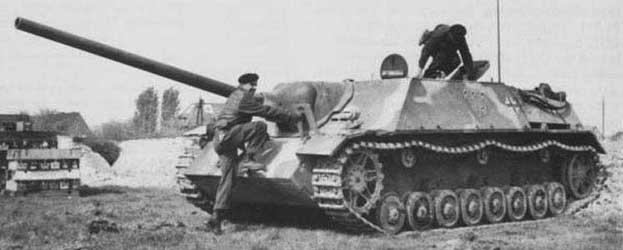 |
Panzer IV/70(V)
|
src: Site "Juggernauts
of the second world war"
|
Le Jagdpanzer IV/70 (V) utilisait bien entendu la caisse et la superstructure du Jagdpanzer IV mais en mai 1944, le blindage supérieur du nez et de la plaque frontale de la superstructure fut monté jusqu'à 80 mm et le blindage latéral jusqu'à 40 mm Au niveau de la suspension, il n'y avait plus que 3 rouleaux porteurs par côtés. Pour ce modèle les châssis du Panzer IV Ausf.H ou Ausf.J sera utilisé.
Jagdpanzer IV/70 (V) used of course the hull and superstructure of Jagdpanzer IV but in May 1944, the higher shielding of the nose and the frontal plate of the superstructure was increased to 80 mm and the side shielding to 40 mm On the level of the suspension, it had now only 3 return rollers by sides. For this model the chassis of Panzer IV Ausf.H or Ausf.J will be used.
75
mm Pak 42 L/70 Penetration of a shielding plate (mm) under a plunging angle of 30° |
|||||||
Ammo |
Weight |
Velocity |
100
m |
500 m |
1000
m |
1500 m |
2000
m |
| PzGr 39 | 6.8 kg |
925 m/s |
138 |
124 |
111 |
99 |
89 |
PzGr 40 |
4.75 kg |
1120 m/s |
194 |
174 |
149 |
127 |
106 |
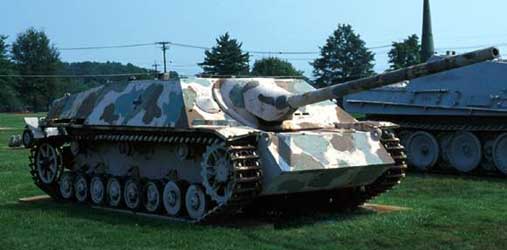 |
Panzer IV/70(V)
(Aberdeen Museum) |
|
|
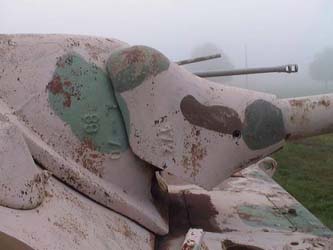 |
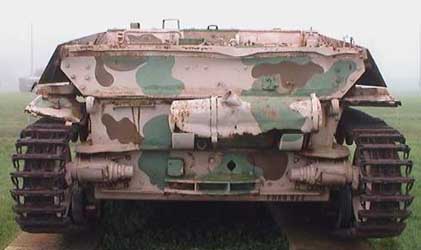 |
Panzer
IV/70(V) (Aberdeen Museum) |
|
|
|
|
Le Panzer IV/70 (V) était armé du canon de 75 mm Pak 42 L/70 sans frein de bouche. Le canon était toujours monté avec un décalage de 20 cm sur la droite. Le L/70 pouvait opérer sur un champ de tir horizontal limité à 12° de chaque côté et un champ de tir vertical variant entre -7° et +15°. Le Jagdpanzer IV/70 (V) ne transportait qu'une MG 34 monté sur le côté droit du canon. Le Jagdpanzer IV/70(V) transportait 55 à 60 coups de 75 mm et 1200 coups de 7.92 mm (MG 34).
Panzer IV/70 (V) was armed with the gun of 75 mm Pak 42 L/70 without muzzle brake. The gun was always assembled with a shift of 20 cm on the right. L/70 could operate on a horizontal field of fire limited to 12° on each side and a vertical field of fire varying between -7° and +15°. Jagdpanzer IV/70 (V) transported only one MG 34 used on the right side of the gun. Jagdpanzer IV/70(V) transported 55 to 60 rounds of 75 mm and 1200 rounds of 7.92 mm (MG 34).
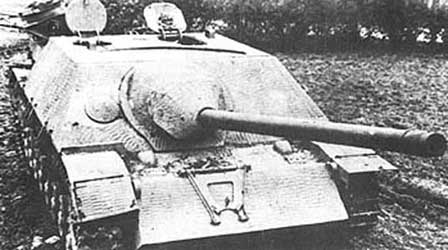 |
Panzer IV/70(V) |
src: Site Panzer
Page von Reitsch
|
Dès septembre de 1944, le Jagdpanzer IV (L/48) et le Jagdpanzer IV/70(V) furent équipés des échappements et des silencieux anti-flammes (Flammentoter). Le long canon et le blindage frontal accru rendirent le nez extrêmement lourd et les véhicules moins mobiles (particulièrement sur terrain rugueux). C'est à cause de cette caractéristique qu'il reçu le surnom de " canard de Guderian " (" Guderian-Ente "). Pour régler partiellement ce problème deux paires roues tout acier furent montées à l'avant du char. Le long canon de 75 mm avait un autre problème, lors des manoeuvres sur terrain difficile, il vibrait énormément et se bloquait même parfois dans la terre ! C'est pourquoi une chaise de route fut installée pour maintenir le canon dans une position rigoureusement fixe lors des transits. Le Panzer IV/70(V) pesait 25.8 tonnes ce qui lui permettait une vitesse sur route de 38 km/h. Le moteur comme sur le Jagdpanzer IV était le Maybach HL 120 TRM.
From September 1944, Jagdpanzer IV (L/48) and Jagdpanzer IV/70(V) were equipped with the exhausts and the anti-flames silencers (Flammentoter). The long gun and the increased frontal shielding made the nose extremely heavy and vehicles less mobile (particularly on rough ground). It's because of this characteristic that it is received the nickname of "duck of Guderian" ("Guderian-Ente"). To regulate partially this problem two front pairs of any steel road wheels were assembled. The long gun of 75 mm had another problem, during the operations on difficult ground, it vibrated enormously and was blocked even sometimes in the ground! This is why a gun lock was installed to maintain the gun in a rigorously fixed position during the transits. Panzer IV/70(V) weighed 25.8 tons what allowed him a speed on road of 38 km/h. The engine as on Jagdpanzer IV was Maybach HL 120 TRM.
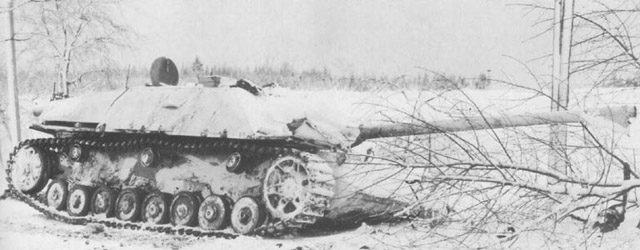 |
Panzer IV/70(V) hors de combat en Europe de
l'ouest, fin 1944-début 1945. |
Panzer IV/70(V)
out of fight in Western Europe, late 1944 -early 1945.
|
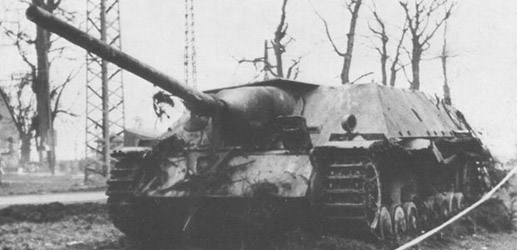 |
Panzer IV/70(V) hors de combat en Europe de
l'ouest, fin 1944-début 1945. |
Panzer IV/70(V)
out of fight in Western Europe, late 1944 -early 1945.
|
Le Panzer IV/70(V) fut également transformé en véhicule de commandement (Befehlswagen) équipé de matériels radio supplémentaires actionné par un cinquième homme d'équipage. On proposa également d'armer le Jagdpanzer IV/70(V) avec un L/70 fixe, mais ce ne fut jamais réalisé.
Panzer IV/70(V) was also transformed into command vehicle (Befehlswagen) equipped with additional radio equipment actuated by a fifth crewman. One also proposed to arm Jagdpanzer IV/70(V) with fixed L/70, but it was never realized.
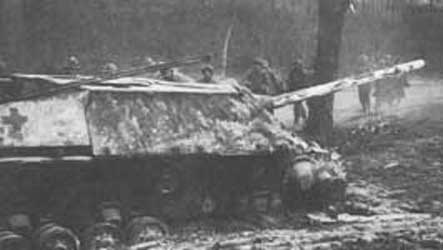 |
Panzer IV/70(V) hors de combat en Allemagne
en 1945. |
Panzer IV/70(V)
knocked out in Germany in 1945. |
En août 1944, les premiers Jagdpanzer IV/70(V)s équipèrent les 105e et 106e Panzerbrigades opérant sur le front occidental. Les véhicules suivant furent versés dans les Panzerjäger Abteilungen des Panzerdivisions et Panzer Grenadier Divisions et également dans les Panzerbrigades. Le Panzer IV/70(V) participa massivement à l'offensive des Ardennes, au nombre de 137. En 1945, des Jagdpanzer IV/70(V)s furent également utilisé comme char de combat pour boucher les trous dans les effectifs, même si cette pratique était une erreur. Jagdpanzer IV/70(V) avec son profile bas était un adversaire difficile à atteindre et son canon antichar de 75 mm L/70 (particulièrement en embuscade) en faisait un adversaire redoutable pour tout char allié même à bonne distance (à part le Stalin). Ce char était avant tout une arme défensive.
In August 1944, first Jagdpanzer IV/70(V)s equipped the 105th and 106th Panzerbrigades on the Western front. The later vehicles were versed in Panzerjäger Abteilungen of Panzerdivisions and Panzer Grenadier Divisions and also in Panzerbrigades. Panzer IV/70(V) took part massively in the offensive of the Ardennes (137). In 1945, of Jagdpanzer IV/70(V)s were also used like tank to stop the holes in strength, even if this practice were an error. Jagdpanzer IV/70(V) with its low profiles was an adversary difficult to reach and its anti-tank gun of 75 mm L/70 (particularly in ambush) made of it a frightening adversary for any Allied tank even at good distance (with share Stalin). This tank was mainly a defensive weapon.
Data |
Drawings |
Sources:
- Pz.Kpfw IV in action, Armor Number 12 (squadron/signal publications, inc.)
- Connaissance de l'Histoire (Hachette) - N°17 - " Les chars de combat allemands 39-45"
- Connaissance de l'Histoire (Hachette) - N°5 - " Véhicules blindés allemands 39-45"
- Les Blindés de la Seconde Guerre Mondiale (Atlas)
- Sturmartillerie & Panzerjäger 1939-1945 (Osprey Military) - New Vanguard N°34
- Site "Achtung Panzer" - http://www.achtungpanzer.com
- Site "WWII Vehicles" - http://www.wwiivehicles.com/germany/tank-hunters/jagdpanzer-iv.asp
- Site "Second World War Armour" - http://www.onwar.com/tanks/index.htm

/Bt-off.jpg)